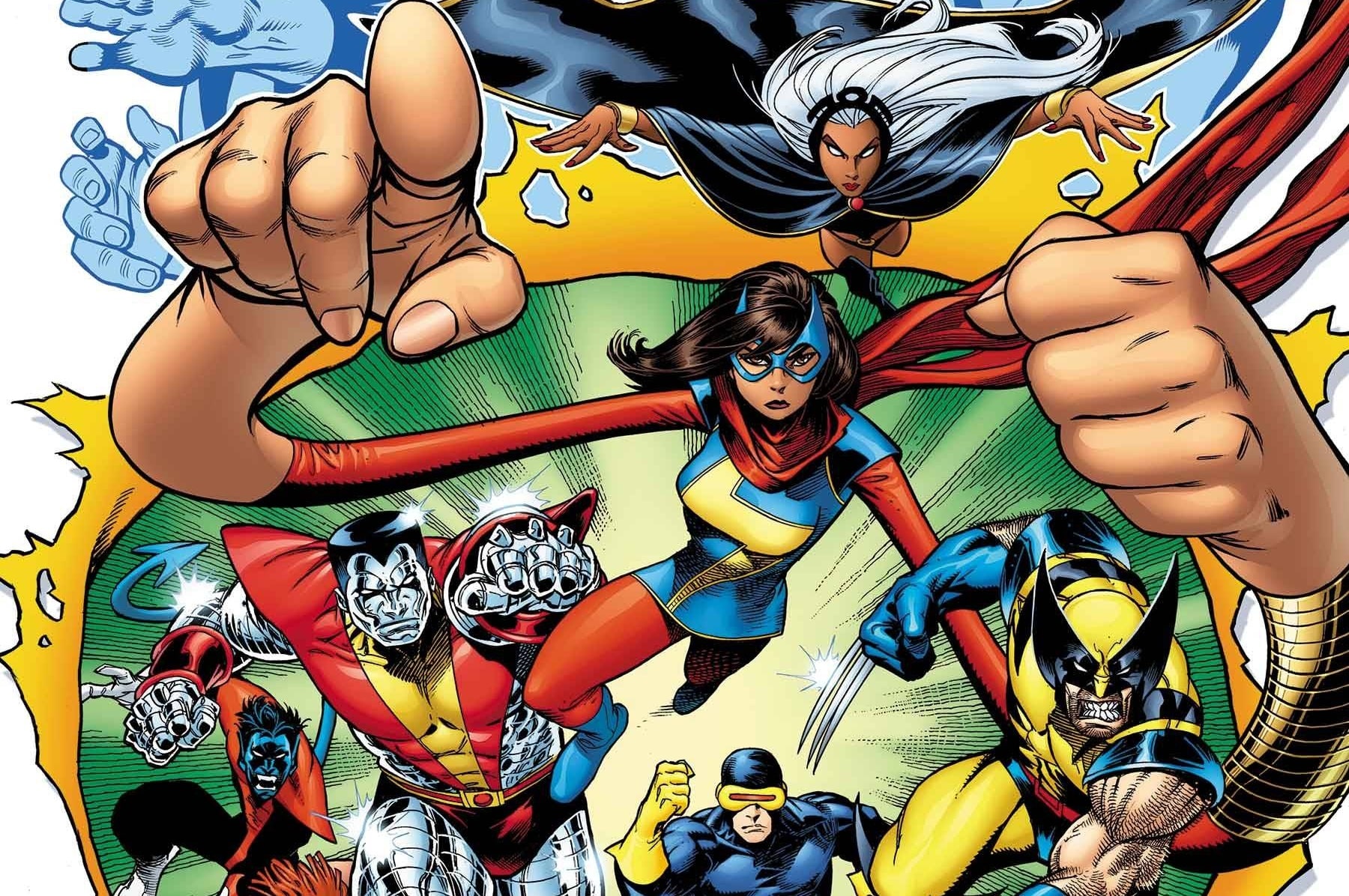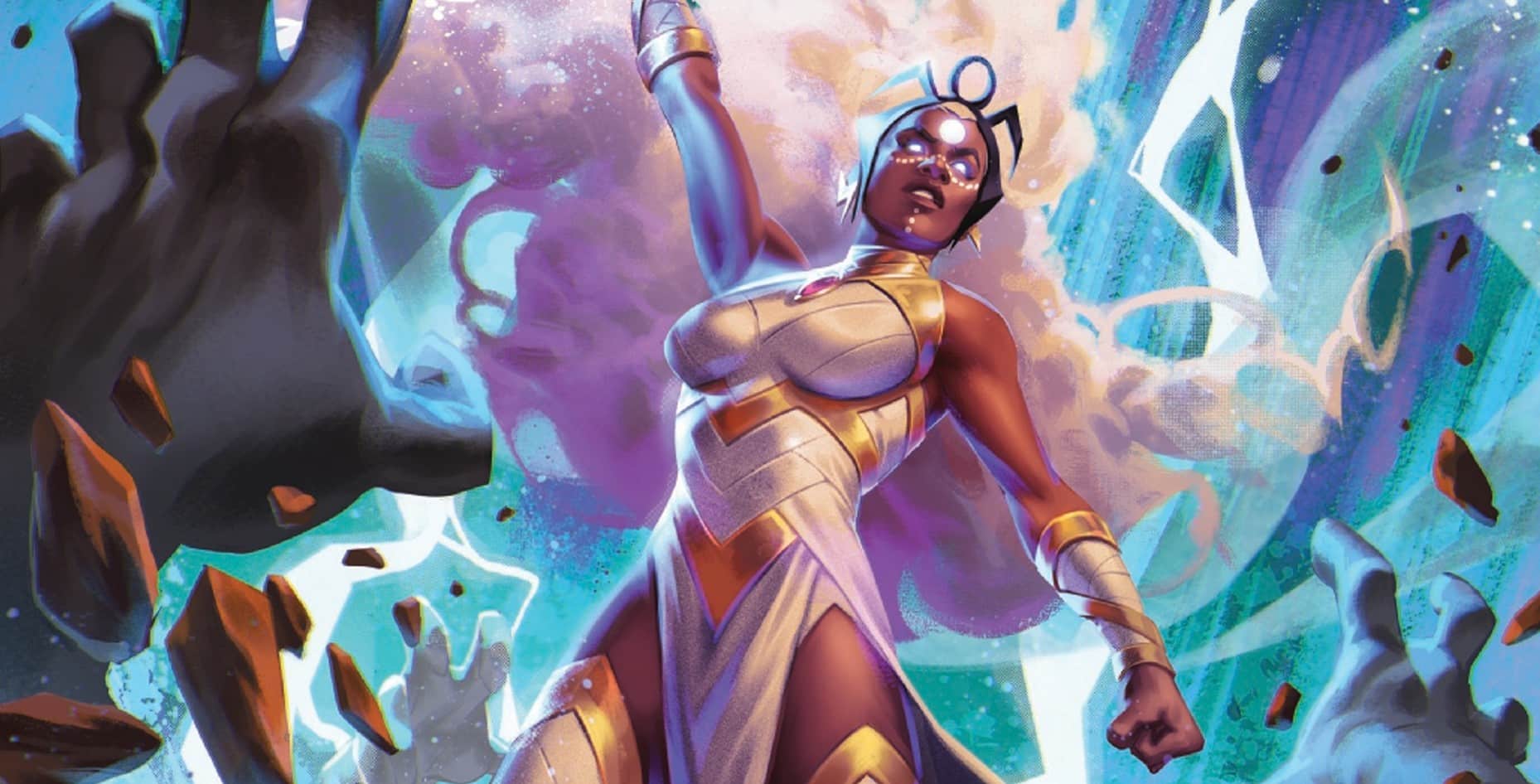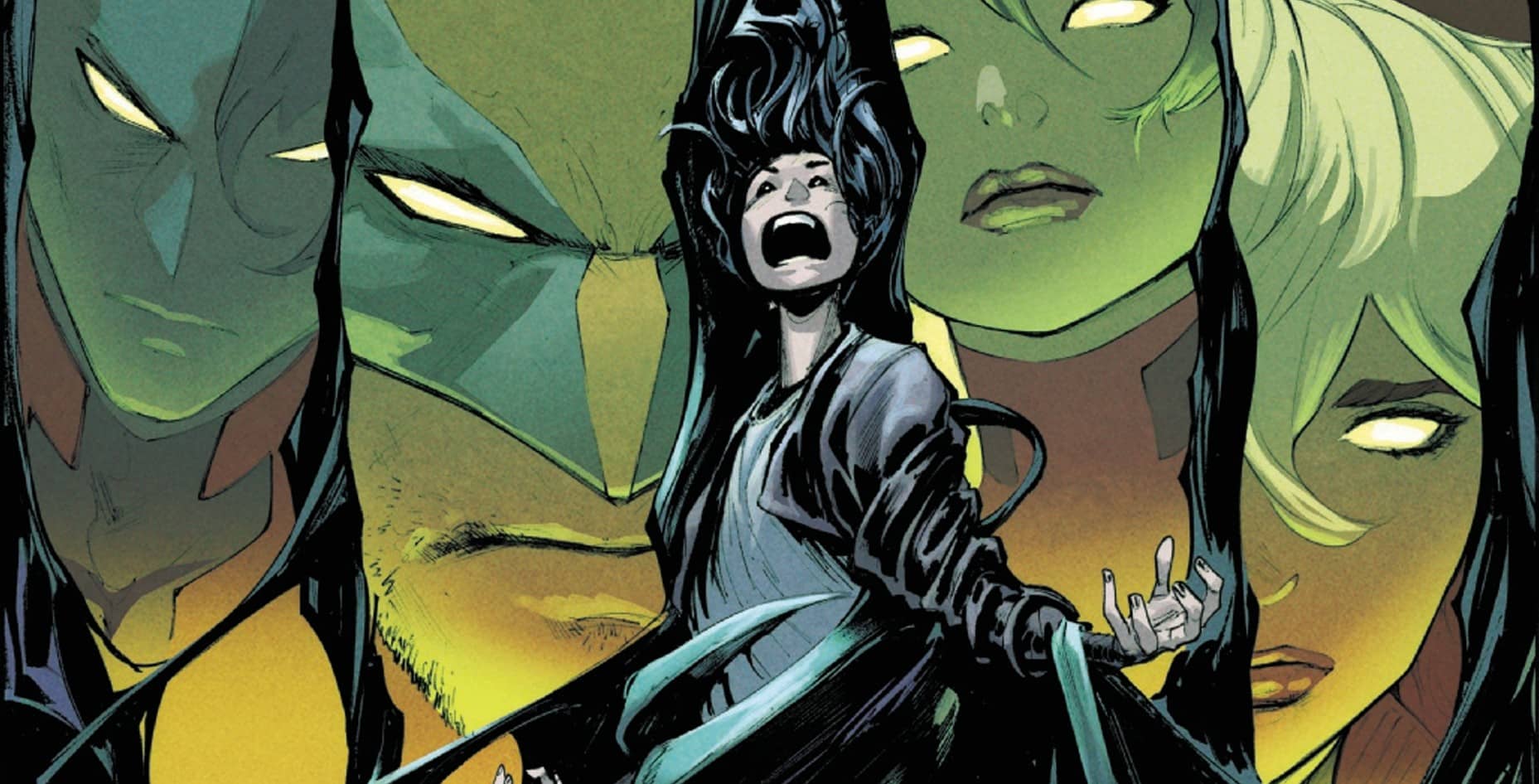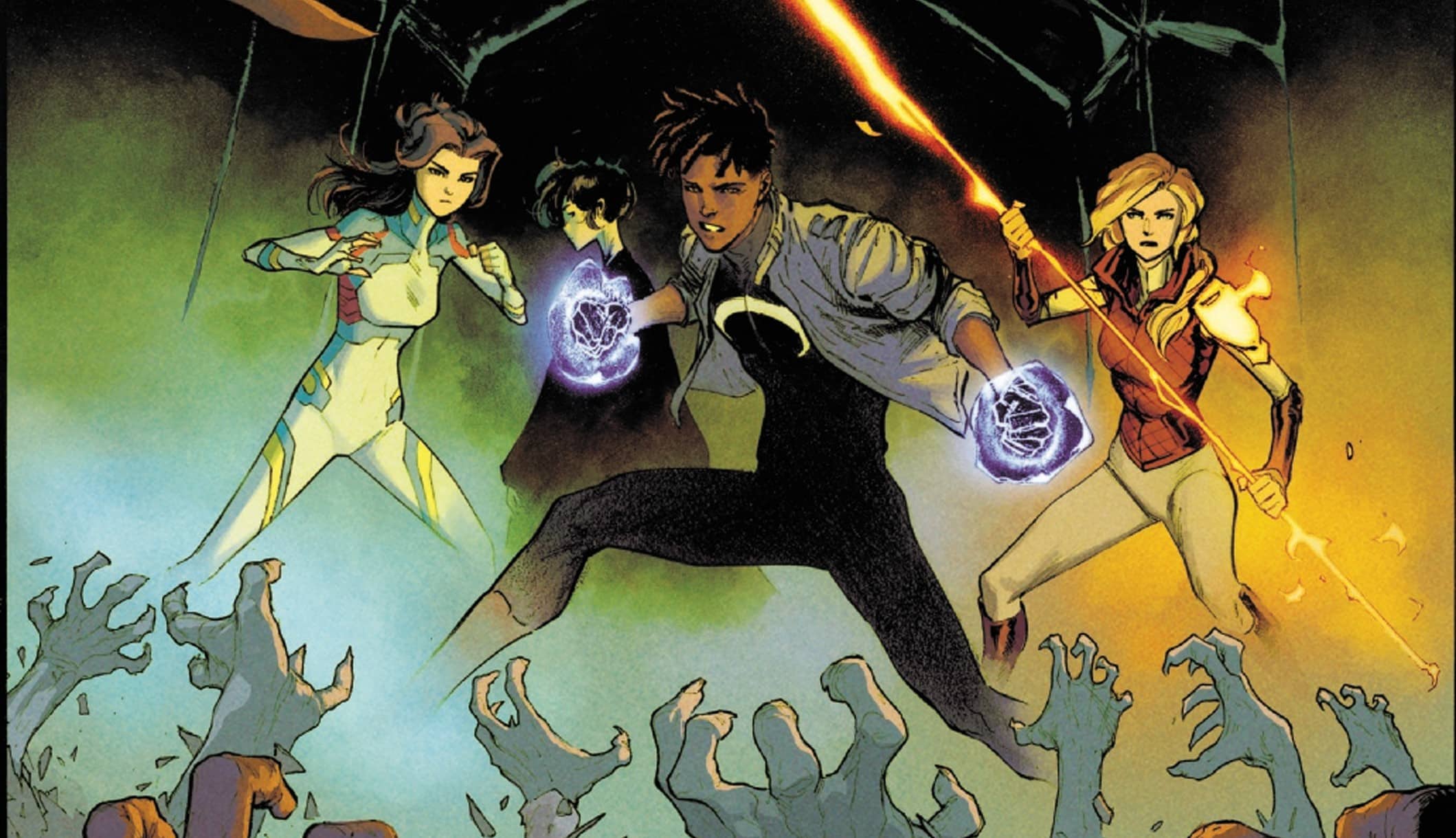Ever since she discovered she was a mutant, Kamala Khan has been balancing her previous life as Ms. Marvel with her role as a leader in the new community, but her conflicted identity has come at a deep personal cost. Now, pulled into the distant past by an unhinged villain with deep ties to mutant history, Ms. Marvel will witness the iconic birth of the second team of X-Men and their first encounter with Krakoa from an all-new, all-different perspective. But when history begins to change, can either Kamala Khan or the X-Men survive the experience? Giant-Size X-Men #1 (not that one) is written by Jackson Lanzing and Collin Kelly, drawn by Adam Kubert, colored by Laura Martin and lettered by Clayton Cowles, with a backup written by Al Ewing, drawn by Sara Pichelli, colored by Federico Blee and lettered by Cowles, “with appreciation for the work of Len Wein and Dave Cockrum.”
Anna Peppard: Remember Kamala Khan? AKA Ms. Marvel? AKA one of Marvel’s most successful, new reader-friendly characters of the past many years? In this comic book, she remains delightful. But that really didn’t help me understand what the heck happened in this story about other stories that also breathlessly retcons those stories on the fly.
Adam Reck: Sure, I remember Kamala Khan! The character tastelessly killed in a Spider-book and resurrected in an X-book to make sure the character matched her mutant MCU counterpart and erstwhile star of NYX, the From the Ashes book I mostly enjoyed until its rushed ending.
Austin Gorton: Has any character beaten the odds and thrived (relatively speaking) more despite being the focal point of two different (and conflicting) corporate directions than Kamala?
Dan Grote: Harley Quinn, maybe? In terms of spending half her life as Joker’s abused sidekick and the other half as DC’s morally gray queer icon, both of which have had successful runs in animation? That’s the only other example I can think of.
Legion at the Apocalypse

Dan Grote: Our story begins presumably in Cable’s future, as a mutant army prays for protection from Mother Askani as it seeks to take on … Legion?
Well, not quite Legion. David Haller, we’ll learn later, went to the White Hot Room (In X-Men #35? At some other time? Who’s to say?). This is an aged corporeal form containing the rest of his personalities, or something. And because Legion’s most famous story is one in which he time traveled and unmade reality, that’s what we’re doing again here.
Hey, wasn’t Legion, like, Nightcrawler’s sword or something the last time we saw him?
Austin: Yeah, but I’m sure we’ll get a story someday bridging the gap between that and this [blinking emoji].
Anna: I don’t mind not knowing what’s going on in this part, since we’re presumably not supposed to understand what’s going on. And this could be a version of Legion from some other time or dimension or past or future or whatever, so I’m less worried about continuity in this particular instance (though Legion’s “we hope you’re still in there, David,” addressed to Krakoa, suggests we are trying to play within current continuity). The apocalyptic imagery is suitably, intriguingly horrifying to set the story in motion, and that’s all that matters here.
Although I will say, I’m not sure how I feel about Kubert seeming to draw Krakoa on a St. Andrew’s cross, a la Marc Silvestri’s famous cover of Uncanny X-Men #251 (which can also be read as a reference to Paul Smith’s cover of Uncanny #169, in which Callisto puts Angel in a similar predicament). I know there are many references to this imagery within other X-Men comics (not to mention culture at large) that don’t exploit the Claremontian BDSM implications of the two examples I’ve cited here, but it still struck me as an odd choice, perhaps speaking to the diminishing returns of this citation within this franchise.
By the way, who do we think is narrating this story? Who does that typeset text belong to?
Adam: All we really know is it’s somebody talking to Mother Askani.
Dan: Also, if Krakoa blinked off to the White Hot Room last year, why does the mutant army in the far future have a hunk of it?
Adam: So many questions!
Kamala arrives in Westchester

Anna: I still can’t quite get my head around Kamala Khan being a central figure in the X-Men franchise, to the point where she’s fannish about mutant history, when I so strongly associate her with the Avengers. I mean, she’s named after an Avenger (who admittedly was also sort of an X-man for a while), and was introduced to Marvel comics as a girl who writes Avengers fanfic. But I know I need to get over it, and I’m doing my best.
Adam: This does track with Ms. Marvel (Vol. 3) #6-7, where Kamala geeks out about meeting Wolverine. But even her having intimate knowledge of X-Men history feels a smidge too meta and has me asking questions about where she would learn about these precise moments.
Anna: I hate to break it to you, Adam, but Wolverine is an Avenger. Or at least he was, right about the same time Kamala coughed on some Terrigen Mist and woke up stretchy. My headcanon says Kamala is a Bendis-era Avengers fan and tags Logan as an Avenger in her fanfic.
Austin: When Kamala can clock that she’s landed in the midst of X-Men #136 before I can, she really starts to feel more like a tool of the creators than an actual character.
Anna: Beyond all of that, there’s something else a bit funny about this comic’s use of Kamala as a POV character, which speaks to my confusion about the goals of this comic (and the series of Kamala-led adventures it’s kicking off). As a relatively new mutant, Kamala is somewhat of an outsider to these events from mutant history. As such, she could be our guide through the past, holding the hands of less encyclopedic-ly minded fans as we mingle with some X-Men greatest hits.
But Kamala is also an insider. She knows more about what’s going on than everyone else in this comic, is better at doing everything than everyone else in this comic, and is kinda sorta the only character who matters in this comic (with the possible exception of Legion, but they’re more of a cipher than a character at this point). If the pitch is to make Kamala the most important character in all of the most important moments of mutant history, that’s one heck of a push. But it’s a push that risks backfiring. Kamala was already special, and so were these stories. Does either become more special through association?
Basically, I can’t decide whether trying this hard to sell Kamala’s importance reflects great confidence or grave doubts about her viability as a headliner.
Dan: Ms. Marvel is a polymorph, able to stretch and change her shape as needed, but she’s also a metamorph, in terms of the way she’s stretched and changed to suit Marvel’s needs over the past 10 years.
She started as a teen superhero for the Obama era, full of hope and change and enthusiasm and belief in the power of good. She was Leslie Knope for comics. She also gave Marvel another character they could put on T-shirts and lunch boxes so they wouldn’t have to use the X-Men and Fantastic Four because it was the 2010s and Ike Perlmutter was mad about film rights or something.
By the time she made her MCU debut in 2022, not only was the world a different place, but Marvel Studios was in the post-Endgame phase where it was throwing all kinds of spaghetti at the walls trying to find something that would stick, with post-credit scenes that fed into nothing and a fixation on a new big bad that had to be quickly erased. In the midst of all that was a slight musical sting toward the end of the last episode of the Ms. Marvel TV series that suggested she could be a mutant. It was just enough to make fans go, “OH SHIT THAT’S THE X-MEN THEME,” but also just enough that Marvel Studios could walk it back if it wanted.
Narrator: The comics did not walk it back.
So while Kamala on the page may be conflicted about her mixed genetics, as shown in the streetlight scene with Bruno, Marvel Comics is all in on her being a mutant. What better way to overdo that, in this era of clinging to the familiar, than by jamming her into all of the Capital-I Important X-Men stories?
Austin: There’s also a weird behind the scenes chicken/egg thing with this story and Kamala’s involvement, which is to say, if NYX hadn’t gotten canceled, would she be in this story and would Lanzing and Kelly be writing it? We can probably assume some kind of 50th anniversary “time travel through the greatest hits” kind of thing was going to happen regardless, but is Kamala the POV character for no reason other than Lanzing and Kelly got the gig, NYX got canceled, and they wanted to keep writing her?
Or did they get the gig because the powers that be decided Kamala needed to be the centerpiece of the big 50th anniversary story as part of the ongoing Make Kamala A Mutant efforts, and they got the gig because they’re the “Ms. Marvel” writers in the X-office?
Adam: I think it’s very possible this is an X-Manhunt-style “back of a napkin” idea from Tommy B. Whatever the case, I would argue that despite the “special” nature of Kamala and/or Giant-Size X-Men, combining them in this way leads to diminishing returns on both. Adding Kamala to the introduction of the All-New, All-Different team adds little to nothing, and the recontextualization that Lanzing and Kelly try to add here doesn’t actually make sense.
Case in point: Cyclops remembers who Kamala is. He shouldn’t. Longtime readers will remember that when the O5 traveled back to the Silver Age, they psychically locked their future memories away like time capsules that would only be released after the events of eXtermination. And since Cyclops should have no memory of Kamala, it also makes no sense why Xavier would.
Austin: This bugged me, a lot, because the mechanics of the O5’s time-travel memories are a big enough deal that if it’s going to be ignored, it needs to be addressed in the story. It just seems like no one involved in the creation of this story knows or cares (or both) about the details, which isn’t a good look.
Dan: Weezie’s Jean Grey mini, the fact the Phoenix Force can exist across all of time like Enigma and last year’s Original X-Men one-shot all wreaked havoc with the resolution of the time-displaced O5 plot, so the answer now in editorial is probably “the characters remember what we tell them to remember when we tell them to remember it.”
Austin: You’re almost certainly right, but I would just like to add that Original X-Men was an AU setup for a dumb but fleeting AU Wolverines team-up story and neither Phoenix nor Jean are pointedly involved in the events of Giant-Size X-Men.
Dan: Good point.
Hey, since we’re in here with the writer of “We Need to Talk about Jean Grey’s Green Dress,” what do we think of Kamala’s ‘70s costume?
Anna: Between Xavier being drawn like he’s cocking an eyebrow at Kamala’s backside, to Kamala saying she likes the miniskirt but is worried her dad will hate it, I can’t say I loved the moment where Kamala dons her version of a ’70s X-Men costume. Besides the weird crotch triangle, the costume itself is mostly fine; visually, it’s really not that much more revealing than Ms. Marvel’s usual duds. But I don’t know if we needed that weird aside about the costume’s sexiness. (I would argue we did not need it — just draw a costume that fits Kamala’s personality and leave the implication of Muslim patriarchal sexual conservatism to some other moment where you can deal with it more sensitively.)
The Island that Walks Like a Man that Doesn’t Do that This Time

Anna: Obviously, trying to make time-travel stories make sense really doesn’t make sense because time travel doesn’t make sense. But what’s fun about time-travel stories is debating the ways time travel might make sense. What’s frustrating me about this one is that the time travel feels less like a fun mental experiment than a hand-wave-y “it is whatever we want it to be; don’t think too hard” kind of thing. I’m just not quite sure I understand the point of, for instance, having Kamala be able to use her future knowledge of Krakoan to speak to Krakoa in the past because for any of that to work, we need to change how Krakoan language works? So instead of being like, “oh cool” I’m like, “wait, what?”
Adam: This is a very important distinction. Kamala tries to speak Krakoan to Krakoa, even though Krakoan is not the native language of Krakoa. Krakoan is a mutant-made language, and it’s made very clear in House of X that the only mutant that can communicate with Krakoa is Doug. It’s kind of a crucial detail to the events of the era. So not only should Kamala not be able to communicate with Krakoa, the fact that it works and it turns into a simulacrum of the Krakoan island from the Krakoan era is doubling down on nonsense that’s not based on any actual X-Men history. Which this miniseries is supposed to be celebrating.
Austin: Also, to be clear, this isn’t just a case of a mistake by omission, like having Kamala talk to Krakoa in Krakoan and the creators not realizing Krakoa shouldn’t understand her; there is specific dialogue about how Krakoa taught this language to Doug and Doug taught it to mutants that is simply wrong.
Adam: Aside from the confusion in the writing, I don’t think the story is done any favors by Adam Kubert’s artwork. There’s a reliance on double-page, turn-the-comic spreads that don’t add much of anything to the pace or clarity of the action. Kubert’s work has historically ranged from being successful in experimental layouts and combinations of drawing styles (Wolverine and Origin) to downright sketchy and sloppy (AXIS). Here the work is leaning to the latter, so much so that the conclusion to the action (Krakoa island flying into the sky) is confusing and lacking detail.
Anna: I genuinely had trouble following the story during this climactic action scene. I would presume the not-new, not-different X-Men get rescued, but because we only see them semi-distinctly in one panel, as silhouette profiles, I’m really not sure. And while Kamala’s line about Krakoa becoming “a giant-size X-man!” was fun, it was a bit odd that this line coincided with Krakoa changing from being a giant-size man-thing to not being a man or particularly giant?
Then Kamala gets sparkle hands to punch Legion, which are presumably a sign that her dormant mutant powers are manifesting. At the risk of sounding Too Old for This Shit, I remain tired of Marvel’s attempts to remake Ms. Marvel by giving her more and more stuff. Kamala wasn’t broken; please stop trying to fix her with five new coats of paint.
We conclude with another time skip and a stinger about Kamala being dropped into “The Dark Phoenix Saga.” I’m sure this forthcoming story will be a fresh new take on an over-told classic and not an editorially mandated effort to make me feel additionally old and tired.
Al Ewing: The Superior Backup-Man

Dan: Al Ewing knows Charles Xavier is a jerk, and what more beautiful language to tell him off in than Italian?
Adam: It’s never a good sign when your comic’s highlight is the backup story. But when you have an All-Star duo of Al Ewing and Sara Pichelli on board, it’s kind of hard to compete. And while we certainly have ZERO need for more Deadly Genesis-era mutants and/or women from Xavier’s past, I can be persuaded with a clever idea for a mutant power and Pichelli essentially drawing hot Italian Snow White putting the professor in his place.
Anna: I wouldn’t say I’m excited about this story, for some of the reasons Adam mentions (more secret women from Xavier’s past is not one of my favourite overused story gimmicks). But at least it’s adding a potentially intriguing new antagonist, rendered with considerable retro verve by the always on-point Pichelli.
Dan: Cripes, now I’m having Sarah Gaunt flashbacks. Thanks, you two.
Austin: At least she gets retconned in more elegantly than Astra did.
X-traneous Thoughts
- Legion talking about the difference between lasers and fire feels like the Hivemind read one of Gail Simone’s more infamous Twitter shitposts and decided to run with it.
- Is that X on Legion’s chest a tattoo? For a gestalt entity that probably hates the X-Men, it sure is A Choice to brand yourself with their logo.
- The best lines of the issue come, predictably, from Kamala, including the following pitch-perfect, upbeat ironic putdown: “Wow, Sunfire. Heard you were very fun — cool to know everyone was being super honest.”
- Missed opportunity for a joke about Kamala and Legion shopping at the same Big Red Sash store.
- Can’t wait to see the super-clever way Al Ewing uses the new mutant’s “superiority” power to make her never have existed in continuity. (This is not sarcastic!)
- If you want to hear what Lanzing and Kelly were thinking, check out the episode of Connor Goldsmith’s Cerebro podcast that just dropped where he chats with them about the book.
Buy Giant-Size X-Men #1 (2025) here. (Disclaimer: As an Amazon Associate, ComicsXF may earn from qualifying purchases.)









